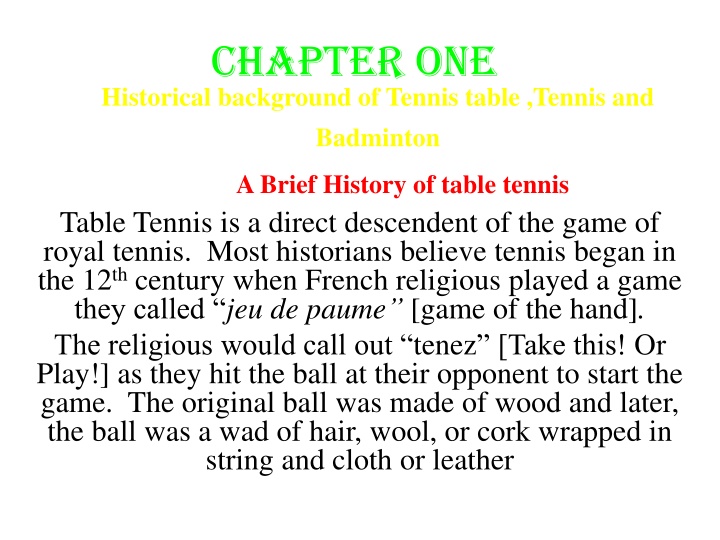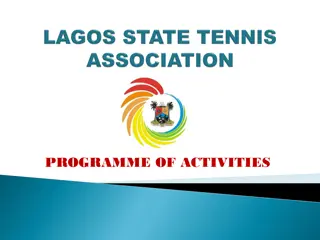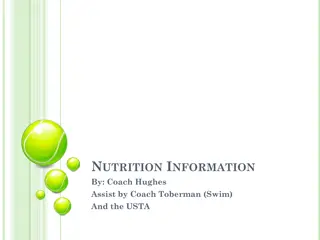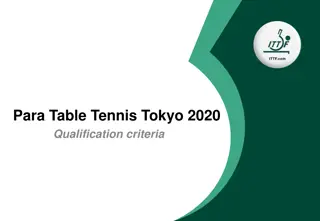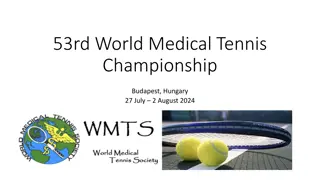Evolution of Tennis: From Royal Origins to Modern Game
Table Tennis, historically descended from royal tennis, has evolved over centuries to become the popular sport we know today. Originating in the 12th century as jeu de paume, tennis transitioned from indoor play to outdoor grass courts, with significant rule changes along the way. The game's development led to modern tennis, a widely played sport with deep historical roots and connections to real tennis and various field games. Tennis is now an Olympic sport enjoyed by all ages and abilities globally.
Download Presentation

Please find below an Image/Link to download the presentation.
The content on the website is provided AS IS for your information and personal use only. It may not be sold, licensed, or shared on other websites without obtaining consent from the author.If you encounter any issues during the download, it is possible that the publisher has removed the file from their server.
You are allowed to download the files provided on this website for personal or commercial use, subject to the condition that they are used lawfully. All files are the property of their respective owners.
The content on the website is provided AS IS for your information and personal use only. It may not be sold, licensed, or shared on other websites without obtaining consent from the author.
E N D
Presentation Transcript
Chapter one Historical background of Tennis table ,Tennis and Badminton ABrief History of table tennis Table Tennis is a direct descendent of the game of royal tennis. Most historians believe tennis began in the 12thcentury when French religious played a game they called jeu de paume [game of the hand]. The religious would call out tenez [Take this! Or Play!] as they hit the ball at their opponent to start the game. The original ball was made of wood and later, the ball was a wad of hair, wool, or cork wrapped in string and cloth or leather
conti The game was played indoors with players hitting the ball into door jams and other imperfections in the walls strategically trying to outjoke their opponent. The net was usually a rope tied across the court five feet high at the sides and drooping to three feet at the middle. The game was played at first with the hand and as time passed gloves were used, and then paddles with webbing, and eventually a handle was added to form a primitive racket.
conti Through the 18thcentury, the game was very popular in France with most noblemen and royalty taking to the game. At this time the game was called royal tennis or Real Tennis and it was played indoors. The game of tennis as we know it today started in 1850 when Charles Goodyear invented a vulcanization process for rubber and the bouncing ball was invented. People began experimenting by playing the game outdoor on grass. In 1874, Major Walter Clopton Wingfield patented the game Lawn Tennis [ Modern Tennis ] and its rules
conti The original court was an hourglass shape and many of the rules were difficult. Many rule changes took place over the years but by 1882 the court, net, and rules of play had become standardized.
Tennis Tennis is a racket sport that can be played individually against a single opponent (singles) or between two teams of two players each (doubles). Each player uses a tennis racket that is strung with cord to strike a hollow rubber ball covered with felt over or around a net and into the opponent's court. The object of the game is to play the ball in such a way that the opponent is not able to play a valid return. The player who is unable to return the ball will not gain a point, while the opposite player will.
conti Tennis is an Olympic sport and is played at all levels of society and at all ages. The sport can be played by anyone who can hold a racket, including wheelchair users. The modern game of tennis originated in Birmingham, England, in the late 19th century as "lawn (grass) tennis . It had close connections both to various field ("lawn") games such as croquet and bowls as well as to the older racket sport of real tennis During most of the 19th century, in fact, the term "tennis" referred to real tennis, not lawn tennis
conti The rules of tennis have changed little since the 1890s. Two exceptions are that from 1908 to 1961 the server had to keep one foot on the ground at all times, and the adoption of the tiebreak in the 1970s. A recent addition to professional tennis has been the adoption of electronic review technology attached with a point challenge system, which allows a player to contest the line call of a point, a system known as Hawk-Eye.
conti Historians believe that the game's ancient origin lay in 12th century northern France, where a ball was struck with the palm of the hand.Louis X of France was a strong player of "game of the palm", which evolved into real tennis, and became famous as the first person to construct indoor tennis courts in the modern style. Louis was unhappy with playing tennis outdoors and accordingly had indoor, enclosed courts made in Paris "around the end of the 13th century
conti It wasn't until the 16th century that rackets came into use, and the game began to be called "tennis", from the French term tenez, which can be translated as "hold!", "receive!" or "take!", an interjection used as a call from the server to his opponent.It was popular in England and France, although the game was only played indoors where the ball could be hit off the wall. Henry was a big follower of this game, which is now known as real tennis
conti In 1954, Van Alen founded the International Tennis Hall of Fame, a non-profit museum in Newport, Rhode Island. The building collection of tennis memorabilia as well as a hall of fame honoring prominent members and tennis players from all over the world. Each year, a grass court tournament and honoring new Hall of Fame members are hosted on its grounds. contains a large an induction ceremony
Badminton Badminton Badminton is a racquet sport played using racquets to hit a shuttlecock across a net. Although it may be played with larger teams, the most common forms of the game are "singles" (with one player per side) and "doubles" (with two players per side). Badminton is often played as a casual outdoor activity in a yard or on a beach; formal games are played on a rectangular indoor court. Points are scored by striking the shuttlecock with the racquet and landing it within the opposing side's half of the court.
History of badminton The game of badminton originated in Siam, China over 2,000 years ago. It was brought to England in 1870 and was played somewhat like tennis. After being played in Canada, badminton arrived in America and has been popular since 1929. Since 1992, badminton has been an Olympic sport, with bird speeds reaching
conti The game developed in British India from the earlier game of battledore and shuttlecock. European play came to be dominated by Denmark but the game has become very popular in Asia, with recent competition dominated by China. Since 1992, badminton has been a Summer Olympic sport with five events: men's singles, women's singles, men's doubles, women's doubles, and mixed doubles. At high levels of play, the sport demands excellent
conti The Badminton Association of England published these rules in 1893 and officially launched the sport at a house called "Dunbar" in Portsmouth on 13 September. The BAE started the first badminton competition, the All England Open Badminton Championships for gentlemen's doubles, ladies' doubles, and mixed doubles, in 1899. Singles competitions were added in 1900 and an England Ireland championship match appeared in 1904.
conti England, Scotland, Wales, Canada, Denmark, France, Ireland, the Netherlands, and New Zealand were the founding members of the International Badminton Federation in 1934, now known as the Badminton World Federation. India joined as an associate in 1936. The BWF now governs international badminton. Although initiated in England, competitive men's badminton has traditionally been dominated in Europe by Denmark. Worldwide, Asian nations have become dominant in international competition. China, Denmark, India, Indonesia, Malaysia, and South Korea are the nations which have consistently produced world-class players in the past few decades, with China being the greatest force in men's and women's competition recently
Chapter two 2.1 Basic rules and regulation of the game of Table Tennis, Tennis, and Badminton 2.1.1 Rules of the Game table tennis: Scoring A match is played best 3 of 5 games (or 4/7 or 5/9). For each game, the first player to reach 11 points wins that game, however a game must be won by at least a two point margin. A point is scored after each ball is put into play (like rally scoring in volleyball). The edges of the table are part of the legal table surface, but not the sides. It is a loss of point if either player volleys the ball during a rally (competition)
Flow of the Match - Singles Each player serves two points in a row and then switch server. However, if a score of 10-10 is reached in any game, then each server serves only one point and then the server is switched. After each game, the players switch side of the table. In the final game (ie 5th game), the players switch side again after either player reaches 5 points.
Flow of the Match Doubles The player on the right side serves on an angle to his opponent on the right side [diagonally across the net]. The return of serve must be played by the server s partner and his shot must be returned by the second opponent. To simplify player alternate taking shots; you can never hit the ball twice in a row. Each server serves two points in a row and then the serve goes to the opponents. After a player finishes serving he/she switch positions with their partner [players should never serve/receive from the same opponent if you are rotating properly].
conti In doubles, at each change of service the previous receiver shall become the server and the partner of the previous server shall become the receiver. If a score of 10-10 is reached in any game, then each server serves only one point and then the server is switched. After each game, the players switch sides of the table. In the final game (ie 5th game), the players switch side again after either team reaches 5 points.
Legal Service The ball must rest on an open hand palm. Then it must be tossed up at least 6 inches and struck(hit) so the ball first bounces on the server's side and then the opponent's side. If the serve is legal except that it touches the net, it is called a let serve. Let serves are not scored and are re-served.
Equipment The paddle should have a red and a black side. The ball should be either orange or white and 40 mm in size. The table should be 2.74 meters long, 1.525 m wide and 0.76 m high.
2.1.2 Basic rules of Tennis Equipment (racket) Under modern rules of tennis, the rackets must follow to the following guideline The hitting area, composed of the strings, must be flat and generally uniform. The frame of the hitting area may not be more than 29 inches (74 cm) in length and 12.5 inches (32 cm) in width. The entire racket must be of a fixed shape, size, weight, and weight distribution. There may not be any energy source built into the rackets. The rackets must not provide any kind of communication, instruction or advice to the player during the match.
conti The rules regarding rackets have changed over time, as material and engineering(production) advances have been made. For example, the maximum length of the frame had been 81 cm until 1997, when it was shortened to 74 cm . https://upload.wikimedia.org/wikipedia/commons/thumb/3/3e/Tennis_Racket_and_Balls.jpg/220px-Tennis_Racket_and_Balls.jpg
Tennis ball Tennis ball Tennis balls were originally made of cloth strips stitched together with thread(cotton) and stuffed with feathers. Modern tennis balls are made of hollow vulcanized rubber with a felt coating (covering). Traditionally white, the predominant color was gradually changed to optic yellow in the latter part of the 20th century to allow for improved visibility. Tennis balls must conform to certain criteria for size, weight, deformation and bounce to be approved for regulation play.
conti The International Tennis Federation (ITF) defines the official diameter as 65.41 68.58 mm . Balls must weigh between 56.0 and 59.4 g. Tennis balls were traditionally manufactured in the United States and Europe . Although the process of producing the balls has remained virtually unchanged for the past 100 years, the majority of manufacturing now takes place in the Far East . The relocation(moving) is due to cheaper labour costs and materials in the region.
Court Tennis court Tennis is played on a rectangular, flat surface. The court is 23.77 m long, and 8.23 m wide for singles matches and 11 m for doubles matches. Additional clear space around the court is required in order for players to reach overrun balls. A net is stretched across the full width of the court, parallel with the baselines, dividing it into two equal ends. It is held up by either a metal rope or cord that can be no more than 0.8 cm. The net is 3 feet 6 inches high at the posts and 3 feet high in the center. The net posts are 0.91 m outside the doubles court on each side or, for a singles net, 0.91 m outside the singles court on each side.
court https://upload.wikimedia.org/wikipedia/commons/thumb/f/f7/Tennis_court_imperial.svg/220px-Tennis_court_imperial.svg.png
CHOICE OF SIDE OR SERVE: To determine who serves first and on which side of the court the players will start, players usually spin the racket. One player spins his/her racket and lets it fall to the ground. As it spins, the other player calls his/her choice. The player who "wins" may choose side OR serve OR may ask his opponent to choose.
SERVING: 1. from behind the baseline on his own right hand side of the court. The ball must go into the receiver's right hand service court. The server then alternates service from right to left side of the court. Two serves are allowed from each side. The game is started by one of the players serving the ball a. Server stands with both feet behind the baseline and between the center mark and the sideline. b. The ball must be hit before it touches the ground. c. The serve is hit diagonally across the net into the proper service court. d. Liners are good. (Balls landing on lines are good)
conti 2. Foot faults on the service a. One or both feet must be on the ground during the serve. b. Both feet must be behind the baseline. Service faults 3. a.All foot faults are service faults. b. Failing to serve the ball into the proper court
conti 4.If the server tosses the ball, swings and misses it completely, a fault is called. However, it is NOT a fault if the server tosses the ball and then does not swing at it. (Lets it hit the ground without swinging at it) 5. Service after a fault is called a. If the fault occurs on the first serve, another serve is taken from the same court. b. If the fault was that you served from the wrong court, you would serve your second ball from the correct service court.
conti 6. A served ball hitting the net and then hitting in the correct court is called a "let" and must be replayed. 7. "Let" serves are repeated, but play continues when the ball touches the net and falls into the proper court during play.
RECEIVING: RECEIVING: 1. The receiver: a. The server must wait until the receiver is ready. b. The point is replayed if the receiver made no attempt to return the ball because he was not ready to receive the serve. c. The receiver may not delay the game. 2. The receiver of the serve can stand anywhere he wishes when the ball is served, but he must let the ball bounce before returning it.
GENERAL PLAYING SITUATIONS: 1. One player serves for an entire game; the next game is served by his/her opponent. 2. The ball is in play from the moment it is served until the moment a let, fault, or point is called. 3. A player loses the point if his body, his racket or his clothing touches the net while the ball is in play.
conti 4.Aplayer may not reach over the net to strike a ball. 5. If a ball lands on a line it is considered good. 6. If a player catches a ball before it strikes the ground outside the lines, he loses the point. 7. A player loses the point if the ball hits him before it bounces. 8. Players change sides of the net after the first game and then every odd numbered game after that (3,5,7,9 etc.)
TENNIS ETIQUETTE: 1. If your ball goes into another court, ask the players to return it when they have completed playing a point. 2. Return the ball gently and directly to the person that asked for it. 3. Play a point over in case of interference. 4. Wait until your opponent is ready before serving.
conti 5. Begin a point as server only if you have TWO tennis balls in your hand. 6. Control your feelings and temper or bad manner. 7. Do not run into a court while a game is in progress. 8. Do not walk behind a court while a serve is in progress. 9. Always ask, don't tell someone to return your ball, and say PLEASE/THANK YOU
conti 10. Always try to win every game you play, but win or lose, be courteous(polite) and thank Don't complain or make excuses---just do better the next time. your opponent. 11. Return balls TO the server, not at him/her. return a fault service if you can help it, and if you do, call the fault IMMEDIATELY. Do not 12. If the first serve does not go in, DO NOT CHASE IT allow the server to serve the second ball.
SCORING IN TENNIS Server Receiver Score Has Won: Has Won: is: 1 point 0 points 15 Love 2 points 0 points 30 Love 3 points 0 points 40 Love 3 points 1 point 40 15 3 points 2 points 40 30 3 points 3 points DEUCE (40 40)
SCORING IN TENNIS 4 points 3 points Advantage IN 3 points 4 points Advantage OUT 5 points 3 points Game, Server 3 points 5 points Game, Receiver 1 point 1 point 15All 2 points 2 points 30All 3 points 3 points DEUCE
1. The Scoring of the Game: a. The server's score is always called FIRST b. Points are scored as follows: 1. No points---Love 2. 1st point---15 3. 2nd point---30 4. 3rd point---40 5. 4th point---Game
conti 6. "Deuce"---each side has 3 points (One side must now win 2 consecutive points to win the game) 7. "Advantage"---The first point after deuce. a. If the server wins the first point after deuce, the score is called "Advantage IN". b. If the receiver wins the first point after deuce, the score iscalled "Advantage OUT".
2. The Scoring of a Set: a. The side first winning six games (6) wins the SET, provided it is ahead by at least 2 games. (If the score is 6 7 or 5 6, play continues until someone gets 2 games ahead. For example: 6--8 or 5--7, etc.) b.An average set takes about 30 minutes to complete. 3. The Scoring of a Match: a. A MATCH consists of the first person or side to win two of three SETS. b. In top men's tournaments, a match may consist of three of five sets.
COURT POSITIONS A. Server and receiver: 1. The server stands close to the baseline and within four feet of the center mark. 2. The receiver stands near the baseline (inside the baseline for a soft serve or when preparing to attack: slightly beyond the baseline for a hard serve) and in a line that bisects the angle where the serve might be hit.
Game, set, match Game A game consists of a sequence of points played with the same player serving. A game is won by the first player to have won at least four points in total and at least two points more than the opponent. The running score of each game is described in a manner irregular to tennis: scores from zero to three points are described as "love", "fifteen", "thirty", and "forty", respectively. If at least three points have been scored by each player, making the player's scores equal at forty respectively, the score is not called out as "forty-forty", but rather as "deuce".
conti If at least three points have been scored by each side and a player has one more point than his opponent, the score of the game is "advantage" for the player in the lead. During informal games, "advantage" can also be called "ad in" or "van in" when the serving player is ahead, and "ad out" or "van out" when the receiving player is ahead.
Set A set consists of a sequence of games played with service alternating between games, ending when the count of games won meets certain criteria. Typically, a player wins a set by winning at least six games and at least two games more than the opponent. If one player has won six games and the opponent five, an additional game is played. If the leading player wins that game, the player wins the set 7 5. If the trailing player wins the game, a tie-break is played.
conti A tie-break, played under a separate set of rules, allows one player to win one more game and thus the set, to give a final set score of 7 6. A "love" set means that the loser of the set won zero games, colloquially termed a 'jam donut' in the USA.In tournament play, the chair umpire announces the winner of the set and the overall score. The final score in sets is always read with the winning player's score first, e.g. "6 2, 4 6, 6 0, 7 5".
Match A match consists of a sequence of sets. The outcome is determined through a best of three or five sets system. Recreational players may agree to play any number of sets, depending upon time availability or stamina.
